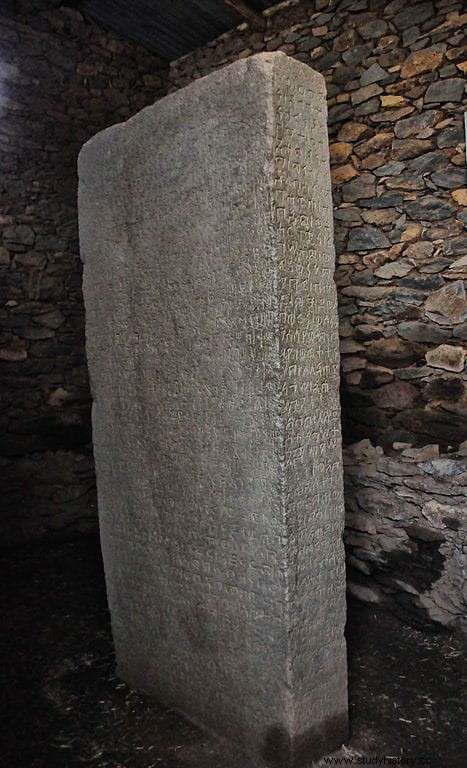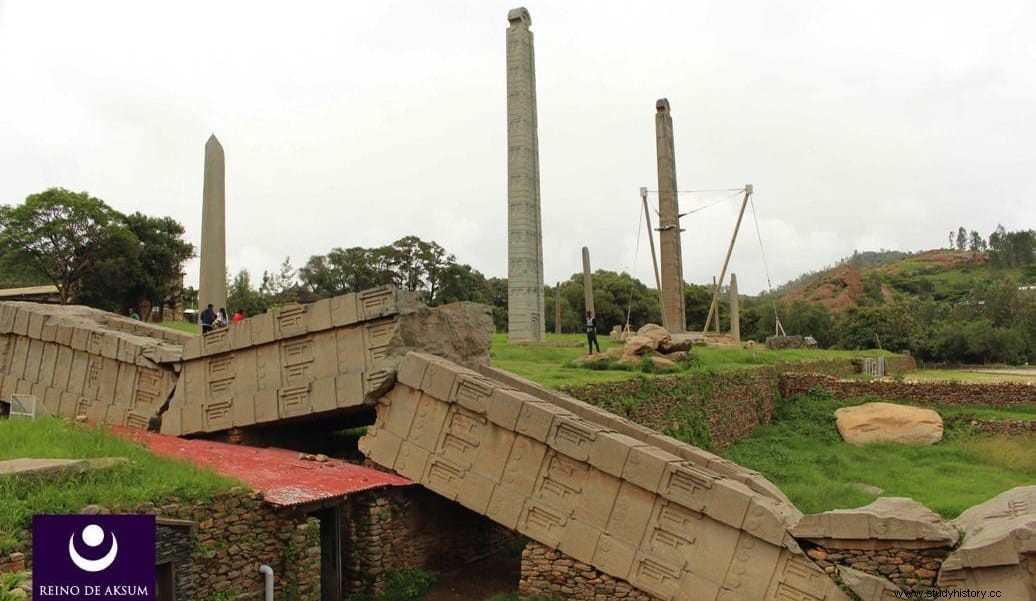If we exclude the sources of the Blue Nile, after all the work of nature, the most important and colorful monument in Ethiopia is the set of churches carved into the rock that are in the town of Lalibela and are part of the World Heritage Site . But in the city of Aksum there is a piece that is priceless for Ethiopian Christians because it documents the origin of their faith in the country and that historians and archaeologists also consider extremely valuable for considering it a local version of the Rosetta Stone, as it is written in three languages and review basic information about the king who ended the Kingdom of Kush. It is the Stone of Ezana.
Aksum is a small and poor city in the Ethiopian state of Tigray, but the country's Orthodox Christians consider it sacred and, consequently, it is their religious capital, receiving thousands of pilgrims every year. Almost two millennia ago it was the nerve center of the homonymous kingdom, which extended from the aforementioned region of Tigray to the southern part of the Sudan, also encompassing Djibouti, Somalia, Eritrea and even parts of Somaliland and the Arabian coast, already on the other side. of the Red Sea, which today are the territories of Yemen and Saudi Arabia. It had its period of splendor between the 1st and 7th centuries AD. but the fall of the Roman Empire and the rise of Islam left the kingdom isolated, causing its decline.

The capital was also included by UNESCO in its World Heritage list, partly because of the modernist architecture of the period of Italian domination but, above all, thanks to the archaeological ruins that make Aksum a particularly interesting site for scholars of the Antiquity:the central square, the Parque de las Estelas, the 4th-century temple on which the neo-Byzantine church of Santa María de Sión was built, the so-called Baños de la Reina de Saba (a reservoir, actually), the palaces of Ta'akha Maryam and Dungur, the tomb of King Bazen, the monasteries of Abba Pentalewon and Abba Liqanos, the Lioness of Gobedra (a relief carved on a rocky outcrop), the urban structures of the suburbs...
Among all these wonders, the Piedra de Ezana appears with deserved attraction, a granite stela that is actually not the only one found in Aksum, since there are a hundred of them, although three stand out above the others:one 33 meters high and 517 tons of weight that was going to be an obelisk - the largest in the world but it broke during its erection - and shows engravings on its four faces; another of 24 meters that is associated with King Ezana and that, transferred in 1937 to Rome, was returned in 2008 to Ethiopia; and the third, 21 meters high, is the oldest and has been standing for two thousand years. Now, the one that interests us here is a room of more modest dimensions -a little taller than a person of medium size- known as Piedra de Ezana and located in the park of the same name.

Like the frustrated obelisk, it has its four faces -the two large ones and the edges- carved with writings that, as we said at the beginning, are in three languages:Sabean and Yehen (or Ge'ez) and classical Greek. The first, sometimes mistakenly called Himyarite, was of Semitic origin, used the Musnad (Southern Arabic) alphabet, and was spoken in the Kingdom of Saba, present-day Yemen, since a millennium BC. The second belonged to the same branch but was used in Ethiopia. As for classical Greek, it was spread throughout practically the entire Mediterranean and its handling was a sign of culture. In this case, it facilitates translation, although it is true that, contrary to what happened with the Egyptian of the Rosetta Stone, Yehen was not a dead language - Sabean was, since it was displaced by Arabic - because it became the official church of the Ethiopian Orthodox Church and in the 4th century AD. a translation of the Bible was even made for her.
That church, also known as Tawahedo, depended for a long time on the patriarch of Alexandria -hence the use of Greek- despite having his own, the abuna . His doctrine is monophysite, according to which Christ did not have two natures - human and divine - but only one. Tradition has it that it was founded by Philip the Deacon after meeting the treasurer of the king of Ethiopia on the way back from a pilgrimage to Jerusalem and managing to convert him to Christianity. Whether true or not, it is true that this religion was established in the country in the fourth century, during the reign of Ezana, who was evangelized by a Greek monk of Syrian-Phoenician origin named Frumencio, who had been appointed his tutor after being released from the slavery to which he was subjected by the pirates who raided his ship and sold him in Aksum.
Appointed bishop of Ethiopia by the Alexandrian patriarch Athanasius, Frumentius baptized the monarch when he ascended the throne and spread the faith, earning the nicknames Kesate Birhan (He who reveals the light) and Abba Salama (Father of peace). He thus became the first abuna . As for Ezana, born around 320 AD, he was still a child when he succeeded his father Ella Amida (who appears on coins as Ousanas) as head of the Kingdom of Aksum. It is not known with certainty how the beginnings of this kingdom were, except that they date back to the 1st century AD. picking up the baton left by Damot and initiating an expansion to the north and south, perhaps by the hand of what some authors consider to be the first monarch -or, at least, the first known-, Zoskales.

In any case, Aksum would have experienced rapid economic growth thanks to large areas of cultivation, a powerful cattle herd and the ivory trade, making the ruler known as the king of kings and that he got a position so stable as to mint money. His power allowed him to unleash annexationist military campaigns against his neighbors and it was precisely during Ezana's reign that many peripheral peoples who became tributaries submitted:Bejas, Afam, Kushites, Agwezat, etc. It seems that an incursion of the Kingdom of Meroe against Aksum was harshly answered with a counterattack that precipitated its collapse around 350, although it is true that it was already in decline, deprived of Roman protection.
The Stone of Ezana narrates that episode but its interpretation is confused and there are those who think that it could be more the story of the war against the Nubians, in which Ezana helped Meroe against the uprising of that people. Because, taking advantage of the fact that his troops had occupied the Meroitic country and thus had a good position, he would also have launched them against the Kingdom of Kush (the name that the Egyptians gave to Nubia), destroying it and leaving it divided into three parts:Alodia, Makuria and Nobatia. It was like this? There is no agreement among historians and the other available sources are ambiguous and insufficient to elucidate it.
What is clear is that the Kingdom of Aksum became so important that contemporary authors considered it one of the four most powerful in the world, along with the Roman Empire, the Sassanian Empire and China. In addition, it happened that it was the second state to adopt Christianity, after Armenia and before Rome, since the Edict of Milan promulgated by Constantine only established freedom of worship and it was necessary to wait for that of Thessaloniki, in the year 380, by which Theodosius officially made the Roman Empire Christian. Of course, a multitude of variants began to emerge and, in that sense, it is curious that the emperor Constantius, who was an Arian, wrote a letter to Ezana requesting that he send Frumentius to Alexandria to be examined for what were considered serious errors. doctrinal and replaced by Theophilus the Indian; the king did not bother to reply.

Proof of this same relevance would be the fact that many Aksumite coins have been found in a place as far away as India, making clear the intensity of trade relations between the two sites. In addition, there is the curious circumstance that these coins were the first in history to be minted showing a Christian cross. And next to her the names of Ezana and his brother -and his successor- Saizana, both canonized by the Ethiopian Church for introducing Christianity together with Frumentius, as the Stone tells. It is not surprising that legend places the arrival of the Ark of the Covenant at the Tana Kirko monastery during his mandate, where it continues to be guarded by a monk who never leaves the chapel where it is jealously guarded from public view because no one can see the face of God.
The Kingdom of Aksum, however, ended up falling. Although another tradition holds the resentful queen Gudit responsible, the truth is that it was the spread of Islam around her that isolated and ruined those unlikely African Christians; "Embraced from all sides by the enemies of their religion" , as Edward Gibbon said. The memory of her would be perpetuated in the medieval myth of Prester John, which the Portuguese thought they had finally discovered when they arrived in Ethiopia in the fifteenth century.
